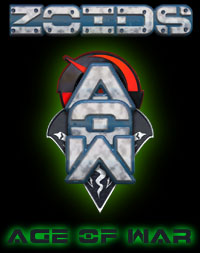
XZ-311 HELLSTORM
Chassis: Meganeura
Power Plant: XPZ3-A4 (Power Zoid – Class 3 Avian, Quad-Wing Drive)
Primary Mission: Aerial Artillery & Assault
Secondary Mission: Airborne Base of Operations
Tirtiary Mission: Air Transport
Crew: 6+ (1 Pilot, 1 Communications engineers, 2 tactical gunners,
2 body/tail gunners)
Statistics (Chassis Only)
Length: 58 meters
Width: 59.5 meters
Height: 19.6 meters
Mass: 275 tons
Performance (Chassis Only)
Land Speed: 25 Kph
Air Speed: MACH 1.2
HISTORY
Kir’Lai considers itself a sovereign nation, though it is regarded as merely a large tribe beyond its borders. Located on the younger and less known eastern continent of Ayeri, the tribe of Kir’Lai maintains lands of rugged deciduous forests, low mountains and trackless swamps. Travel over land is very difficult, and they have harnessed the power and flexibility of the indigenous giant dragonflies for centuries as both transports and defenders. When the kingdom of Helic was pushed to the ocean by the genocidal Zenevas the Kir’Lai found a war raging far too close to their northern border than they could ignore. Their standard defense Zoid, the XZ-019 Fireshock, was woefully inadequate against all but the lightest units of these potential enemies.
DEFENSES
Maneuverability is the foremost defense of the XZ-311, however, its massive power plant and magnesser wings allow it to carry substantial armor. The durable frame supports heavy armor for any unit, air or land, using layers of ceramics, composites, and metals that allow it to shrug off most light weapons fire. The Hellstorm has many redundant structural and electronic systems that add to its survivability. Its ECM suite is limited by the simpler technology of the Kir’Lai, however, and Sensory Defeating Materials, absorbent paint, and coolant cowlings are only adequate in reducing enemies’ targeting systems. The suite is expanded with all manner of jammers, canister countermeasures, scramblers, and static field generators to confound a very wide range of sensory and communications equipment. It can attempt to shoot down incoming projectiles with Gatling or beam weapons but also carries small antimissiles that can intercept closing rounds.
CAPABILITIES
Though the Hellstorm flies at only three-quarters of MACH at sea level, it is possibly the single most maneuverable aerial Zoids exceeding 100 tons and can fly rings around virtually any ground unit. The XZ-311 can maintain speeds of 500 kph flying … sideways ... and 350 kph in reverse. It can maintain a 90° pitch or yaw for extended periods while holding forward or reverse momentum. The meganeura chassis enables excellent VTOL capability but also HTOL (Horizontal Take Off and Landing); the Hellstorm can rotate 90° and land on the sheer side of a mountain or, if a structure allows it, upside down. It comes up short on land-based travel, however, being limited to only 25 kph. It can lift its own weight in addition to a full weapons’ load, though all maneuvers and top end speeds are reduced by half. Using six booster engines and a truly massive pair of core-tap engine pods, the Hellstorm can exceed MACH 1 for short stints.
ARMAMENT
The XZ-311 is more than adequate at dealing out the pain. It carries a substantial number of direct fire weapons, both cannons and guns, projectile and energy based, and even supports airborne artillery. It’s lifting capacity and maneuverability also makes it a perfect missile delivery platform, and it carries more than its share of warhead delivery vehicles.
“Tornado” 25mm Gatling Cannon (2) – Thorax turret mounted, 360° arc, 80° vertical inclination
Mounted beneath the thorax of the XZ-311 is an armored turret with a pair of 25mm cyclic cannons, allowing it to target and tear into most light to medium class targets within 2 kilometers. The guns fire 20 rounds per second in up to 6 second bursts and draw ammunition from a pair of internally mounted drums, each holding 3,000 rounds. Shells are returned to the drum after rounds are fired, helping to maintain the Hellstorm’s weight ratios and to conserve resources. In a pinch, the Tornado can be set as a somewhat efficient close-in defense gun.
A third and fourth Tornado is mounted one in each weapon wing. These guns are integrated with a minor 10° tracking gamut but can operate at any position the wings take in their arc. Each gun has a 1,500 round ammo drum mounted aft that can be replaced with a higher capacity drum if wing adjustments are disabled.
“Raider-5” 50mm Pulse Cannon (2) – Thorax turret mounted (dorsal), 360° arc, 90° inclination
This pilot or gunner controlled defense weapon is mounted atop the prothorax; the body segment between the head and thorax proper. Mounted as a pair, it was designed to fill the upper-forward firing arc with rapid bursts of condensed neutrons. While designed to fire on avian targets with softer armor at ranges up to 3 kilometers, some gunners have been able to successfully shoot down slower incoming projectiles.
Garrin-Hayes 240-A9 50mm Beam Cannon (4) – Thorax mounted, 145° lateral arcs, 120° vertical inclination
An updated form of older blue-band laser technology, these weapons have exceptional range for a beam weapon and can deliver substantial damage even at 8 kilometers distant. Within 1 kilometer they almost instantly vaporize through common armor types and can even damage a Zoid through e-shields if the focus is accurate. There are four of these cannons carried by the Hellstorm mounted in pairs. Though each turret rotates a pair of cannons, they incline and decline independently, allowing them to spread their fire.
Rocker 4-A4 35mm Beam Cannon (2) – Abomen mounted, 200° rear arcs, 40° inclination
A later addition to the Hellstorm’s armament, the Rocker beam cannons were placed to deter heavier avian Zoids from taking position behind the XZ-311. A pair of them are mounted in a heavily armored, manned turret directly under the lower dorsal vernier cowl, with an arc that can swing to 15° forward of its position and a computer can time the shots to pass between wing beats. The gun can pierce moderate armor at up to 4 kilometers distance and can rend much lighter targets at almost 6 kilometers away.
Shadow Dancer Anti-Zoid Missile (10) – Thorax (weapon wing) mounted, forward arc
Considered a short range but very nimble missile with a potent area effect warhead, the Shadow Dancer is a silhouette seeker that an strike targets up to 5 kilometers away or within 50 meters. They explode to send superheated shrapnel out with deadly force up to 20 meters off target, making them a quick and dirty weapon to use against swarms of lighter Zoids, especially avian targets.
“Thunder Road” 1,000 kg Cluster Munitions Missile (4) – Thorax (weapon wing) mounted, forward arc
A two-mode warhead for use against multiple light-to-medium ground targets, or against a single larger target, the Thunder Road can spread bomblets in a path 30 meters wide by 50 meters long, or it can retain them and detonate all submunitions on impact. While not as effective as the heavy armor piercing missiles carried by many other Zoids, it has been found that the submunitions’ ability to damage exposed sensitive systems balances the weapon out. This missile has a range of 16 kilometers.
“Skymaul” 180mm Cannon (2) – Abdomen mounted, rear arc, fixed
Mounted upon each side of the Hellstorm’s tail is a Skymaul; a cable-fed 180mm APEX cannon designed to punish even heavy Zoids at range. Each gun has a rail-based magazine traversing the inner skin of the long abdomen, feeding 500 rounds of heavy ammunition through the mount. The Skymaul has a range of 20 kilometers and can leave a crater where a Zatton once stood. However, the big guns are not accurate enough for air targets unless they are slow and lumbering, and the Hellstorm can best use them at a hover.
“Sunlance” 150mm Particle Cannon (1) – Abdomen mounted, rear arc, fixed
Within the long abdomen of the XZ-311 is the Sunlance; a terrifying beam weapon that can pierce through the heart of an Iron Kong at more than 10 kilometers. This piece of beam artillery was designed to be mounted on the defensive walls of state cities, but the incredible lifting capacity and power supply of the Hellstorm allow it to carry and utilize it. Before use the XZ-311 must switch all primary power to the gun, leaving only enough for minimal maneuvering and some defensive systems. After the shot the weapon requires a cooling and replenishment time of several minutes (depending on altitude). Still its one shot, one kill ability makes it a much feared weapon.
Hardened Alloy Jaws – Head mounted, integrated, 60° arc
A bite from the huge, reinforced jaws of the Hellstorm can rend almost any airborne Zoid to pieces, and can snap the head from most land based units in moments. Rather than having a single large blade like many Zoids, it possesses cillerae that cut and rip apart enemies like talons.
Hardened Alloy Claws (6) – Leg mounted, integrated, 90° lower arc
Designed to haul heavy loads and latch onto any available landing surface, the claws of the XZ-311 are quite strong. It can grapple with them easily and then tear lighter units limb from limb, or hold them while the Hellstorm smashes them into the ground from kilometers in the sky or tears through them point-blank with its Tornado Gatling cannons.
AI-2 PROFILE
The Hellstorm lacks a full AI-2 system and relies instead on RANS technology; Reactionary Artificial Nervous System. Essentially the pilot maintains total control of the machine’s direction but it maintains an awareness of its surroundings and can override the pilot in certain situations. While the pilot pushes the Hellstorm due east it can dodge and evade incoming fire while maintaining its course. This system also avoids harmful collisions, so a pilot can fly at top speed through heavily forested mountain peaks almost without looking where he is going. While excellent for survival, the system also means that gunners aboard the XZ-311 must have hair-triggers and reflexes tight enough to counter any automatic sporadic maneuvers.
PARTS LIST
The purpose of this project was to build a Zoid that contained absolutely no Zoid parts... not even the caps that give a kit the distinct appearance of a Zoid kit. Only the pilots were used for scale and continuity. As you will see from the following list, the origins of Hellstorm's bits and pieces are quite diverse.
ZOID MODEL PARTS
Pilots!
NON-ZOID MODEL & TOY PARTS
Bionicle Pieces
Mandibles, head armor, leg bases,
Ante-alar ridge (wing support structure),
power cable management,
AH-1 Apache Helicopter
Power core parts, gunner controls
Battleship USS Arizona
Engine room details & structures, sensor systems
Vector unit details, pilot and gunner controls
Warhammer 40,000 Land Raider
Gatling cannons, beam cannons, sensor arrays,
turret gun system, lateral cannon systems,
engine nacelles, cockpit ladders
Struxx
Legs, joints, prothorax structure
Novelty Store Sword Blades
Wing membranes
Novelty Store Sword Handles
Engine nacelles
SD Gundam
Canopy elevation system
Transformers G1 Jetfire (Engines)
Engine intakes & exhausts
Nylon RC Plane Hinges
Ante-alar (shoulder) cover hinge
Robart RC Plane Hinges
Canopy hinges, (probably main antennae)
Toy Crane Wheel
Primary receiver dish
F-14 Ejection Seats
Um… ejection seats!
LEDs
Simple oculi
HOUSEHOLD ITEM PARTS
Pacifier Case
Thorax armor
GE Telephone Belt Clip
Ante-alar armor cover
Baby Food Bottles
Abdomen sections
Glade Air Freshener Cap
Abdomen end
Soft Soap Dispenser
Tail cannons, power core
Primary receiver array support
Primary artillery bore/vent?
Deodorant Knobs
Power core ventilators, thorax mount
Deodorant Caps
Head armor, compound eye windshields
Axe Body Wash Bottles
Leg armor, vector unit cowling
Axe Body Wash Caps
Prothorax armor
Necklace Chains
Armored power cables
Sheet Polystyrene
Many internal support structures
and scratch built details
Aluminum Tubing
Gatling cannon barrels, hydraulics
Brass Tubing
Wing supports, hydraulics
Robart Nylon Hinges
Canopy hinges & prop rods
Gillette Disposable Razors
Legs & claws
Remington Razor
Engine intake screens (foil),
ante-alar cooling coils (blades)
Pop Bottle Cap
Gatling turret mount
Motherboard Capacitors
Ordinance, sensor systems
Motherboard Transistors
Sensor systems
Motherboard SATA Connectors
Antenna arrays
Video Card Processor
Sensor Array
AC Adapter
Shoulder structure base, tail cannon bore
Capacitor Surface Mounts
Sensors and surface details
Dawn Dish Soap Caps
Defense turret, thorax/abdomen socket
DIP Shunts
Sensor arrays
Blood Sugar Meter Lancettes (UNUSED!!!)
Caps,head antenna mount
Tie Hangers
Tail antennae
SUMMARY
The XZ-311 Hellstorm is a simple and efficient brute of a machine. It has been maintained as the mainstay of the Kir’Lai arsenal for generations and has a reputation bordering on legendary. It is considered the pinnacle of a soldier’s career to have served aboard the XZ-311, and all warriors nod a in salute to those with the dragonfly tattoo upon their left brow.
FAST & STRONG
I have always been fascinated by dragonflies, and to me the most incredible one is the meganeura, a megafauna insect and, quite possibly, the largest insect ever to have lived. While dragonflies remind me primarily of gunship helicopters due to their form, maneuverability, and hunting prowess, I wanted to depart a little from this by making a really large Zoid more akin to my EZ-501 Fusillade centipede. A dragonfly this big could easily be made into an airlift helicopter like the Sikorski Skycrane, but I had a vision of a small nation that relied on this one Zoid for their ultimate defense, and decided to build it more after the Hercules Spectre Gunship with a little WW2 flying fortress in the mix. Fiding really good images of dragonfly anatomy proved difficult, as well; especially the head. That was the direction behind the concept, but I wanted to do something completely new for the techniques of the build itself....
THE BUILD

THORAX
There was no chassis for this build! The body is a plastic case for a set of baby pacifiers. The shape reminded me strongly of the thorax of a dragonfly, which was an insect I had been studying to build a tiny gunship Zoid. But this would be a BIG dragonfly if that were its thorax! It was a hollow case, which meant that I could stuff it with all sorts of internal components. That was when I really decided to use an assortment of parts other than Zoids. My parts bin is full of not only Zoid and model parts, but I have a stock of unusual and handy plastic shapes from soap containers, toothpaste caps, deodorant sticks, shampoo bottles... anything that could be integrated into customs as armor, frames, or equipment. The first thing I fished out of the bottle bag was the central power core, made from a shampoo lid, two deodorant dials, and the base of a soft soap pump. To see these details, I cut windows in the thorax armor. It would be a waste if these windows showed so little detail; so I started stuffing that space with anything interesting.
A ... NON-ZOID
The thought of doing something entirely original struck me as I was getting the recycling ready for the curb. I looked at some of our bottles from shampoo and baby food and thought, “they are really making some fascinating shapes in bottles these days! How long would it take me to try to sculpt that in sheet styrene?” This evolved into a challenge to myself to create an entirely new custom that used NO Zoid parts. I would allow myself to use Zoid pilots to maintain a solid appearance of being a part of the Zoids world, but everything else would have to come from other sources. The size of most plastic containers solidified that this model would have to be large (it's hard to find a great variety of tiny bottles!) As I gathered enough parts to start the build it became apparent that, yes, it was going to be quite large... like "Seismosaurus-length" large. As the build took shape, it became noteably difficult to construct parts that would have been far less challenging if I used them; especially when it came to the legs.

INTERNAL AFFAIRS
As I built the thorax internal structures I focused on making them look very functional, but also making them visible through the windows in the armor. There are several pieces that cross over the seam that had to remain only half adhered during this part of the build, and the loose cables were always trying to escape. And this was just the inside of one component of the whole dragonfly.

COWLING DETAILS
Here is a close-up of the thrusters in their natural environment. The small, upper cowl holds a pair of thrusters and some other gear, which I’ve decided are various countermeasure systems. The larger, lower cowl hides four thruster banks and yet more countermeasure gear. (NOTE: I may add some cabling here if there is time).
THE HEART OF THE MATTER
I wanted to see all sorts of very mechanical looking things in the engine room, and a lot of cabling draped about. I used Bionacle parts for cable control points and wrapped them around the space. The green parts above are from a (very poor) Tamaya Heuy Cobra that I used as generators and structural systems. The light gray parts are from the USS Arizona. The bridge segments were used for table distribution and the two cool-looking pistons are actually the seaplane cranes from the battleship's deck. There are 12 necklace chain cables threading around the engine compartment.

PITCH & YAW
Finally we see the thrusters in place. They are actually quite agile components, and can lie low over the tail or raise almost straight up. The upper cowl can even rotate 360° and could face forward to act as a massive speed break. Both are attached in Bionacle ball sockets, so they can swing to the sides and rotate as well. The Hellstorm can twist them one to a side to provide higher forward thrust, or back and down for more lift. I love the result!
VECTOR ASSEMBLIES
Early on I wanted to do something with these Axe shampoo bottles; they had very cool, insect-like shapes. With Hellstorm, I saw my chance, cutting out the most insect-y parts of the bottles. The body and tail of a dragonfly isn’t very impressive, really, and since this is a machine of war, I wanted to make it look bigger and badder. I collected a number of disposable razor heads because they looked interesting to me (yes, they are all sanitized, and yes, they are all still dangerously sharp!) To me they appeared as vents, or, in this case, vectoring thrusters. I packed them into the aft cowlings along with random model parts.
BUILDING ONE HUGE HEAD
It really all started with a pair of deodorant caps, and that grew to three deodorant caps, a base, and a handful of Bionacle parts. The caps looked to me like huge bug eyes, and were actually the inspiration to make a dragonfly. It took a lot of trimming to get everything to fit right, but these shots show the original bits temporarily in place. The three plastic BBs were place holders made from the projectiles of the Diablo Tiger; since I couldn’t use any Zoid parts in this project, I would end up replacing them later. As it is, at this point I knew I had to build this bug, and I knew it would be huge. In fact, I envisioned it having four pilots, two in each compound eye.
CREW STATIONS
In the past I had built seats out of hinges or other plastic bits, but since these would be suspended inside the huge, clear canopies of the dragonfly’s eyes, I wanted them to look much better. I ordered two pairs of 1/72 F-14 Tomcat ejection seats that I modified for Zoid pilots. Each is placed on a polystyrene deck to support the crew’s feet and an arm made out of a motherboard memory stick lock to suspend the seat out from the head. There are two pilot seats and two gunner seats with different controls. The pilot seats are designed to be mounted low and in front, the gunners are high and behind, like a modern attack helicopter.
SEATING FOR FOUR
The cockpit glass is hinged at the top with a working prop rod that rests in part of a Gundam helmet to hold the canopy up for boarding. The funny thing was, the seats fit incredibly well, but the glass couldn’t close over them! In order to open and close the eye lenses you have to rotate the lower seats 45° backward, close the canopy 90% of the way, then use tweezers to set the seat back forward again. The lower seats had to be mounted on a brass post to pull this off. In the end, they look really, really cool! You can also see in these shots that I replaced the plastic BBs with green LEDs. Unfortunately, at this stage, they do NOT light up… if only I had more time!
SHOULDERING THE BURDEN
The base pieces for the shoulders (the mount for the wings) was a sawed down Bionacle torso. It just so happens that Struxx pegs fit perfectly into the holes, allowing the wings to rotate in addition to flex. The angle wasn’t sharp enough, though, so I cut an old AC power adapter apart and used it to shim up the back. It was then time to dress it all up. I had a pair of blown motherboards that I spent a few hours yanking everything I could off of. I would use everything from SATA jacks to semiconductors to add detail, mostly acting as sensors of different kinds. While all of this would work for complex-looking innards, frame 3 shows some outer details: the belt clip from an old phone acts as the “hood” and cowling for the inner sensors, a pair of spend electric shaver blades became lateral exhaust units, and the tractor hubcap acted as the central receiving dish. The pair of foot-shaped Asoblocks looked like nice armored intakes. The last image shows the placement of the vectoring unit hinges.
NERVE CENTER
Image 1 shows all parts in place with the armored cowling closed. You can see some cables were added and a few surface sensors grace the shoulder frame. Image 2 demonstrates the hood in the raised position; it is hinged with nylon RC aircraft aileron hinges (which I commonly use in almost all of my builds) At this point a prop-rod has not been added, so I’m using a file to hold up the armor. Frame 3 shows a ¾ view of the interior details; most of these are computer parts, but the central receiver array is from the USS Arizona floating over the main dish using a pen spring cut down to size. The last frame shows the location of the 12 different antennas and sensors packed into just the forward shoulders of the Hellstorm.
WINGING IT
Soon after I collected the deodorant caps that looked like huge bug eyes, I was shopping for Halloween costum stuff for my toddler at a local dollar store (everything there costs $1.00 USD; great for parts… not so great for food…). Anyway, we saw these cheap plastic swords and both of us instantly thought the blades looked perfect for huge bug wings. We purchased the only four blue swords they had and took them home and immediately ripped them apart. They have a notch in them that happens to fit the Struxx double joints perfectly. As cool as they look, the plastic is very soft and they sag within an hour or so. I purchased four brass rods to place under them for support, then dressed them up with various little bits and pieces from model kits to more circuit board refuse. The final model has a wingspan of about 34”.
SERIOUS ENGINES
A pair of completely different cheap plastic swords from the Dollar Store yielded their handles to become the huge engines of the Hellstorm. At first I thought they looked perfect, then I thought they looked too big, then I set them over the nearly completed model and thought they looked perfect again. The build for these was easy; just cut the ends off and glue an engine support and exhaust bell from some spare G1 Transformers Jetfire parts. Behind the 45° twisted intake is a fine grating taken from the foil of an electric razor. I also opened up the now gutted battery compartment and added a hinge and some internal details. The engine door can be raised as an airbrake and, well, it just looks cool that it can do that.
KER'LAI
Independent Tribe
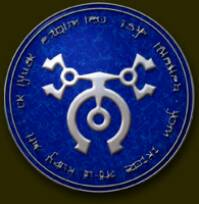
HISTORY (continued)
Centuries ago the Kir’Lai Chieftain, Iramus, commanded his bravest men to capture the largest and deadliest of the feral dragonflies, the giant meganeura. This Zoid’s core would be implanted into the most ambitious frame that the tribal engineers could create. The design was based off of the largest industrial transport serving Kir’Lai, but it was double the size and its lifting capacity was greatly enhanced with magnesser technology recovered from a fallen Salamander. The design allowed almost seamless integration of the meganeura core, and the simplicity of the insect’s brain allowed for easy inclusion of manual controls. The Kir’Lai had their champion, known in modern times as the XZ-311 Hellstorm.
CAPABILITIES (continued)
The sensory suite of the XZ-311 makes up for a lack of sophisticated technology with redundancy of simpler, time-tested components. Basic scanners and sensors send and receive from a horde of antennae, radomes, blades, and lenses jutting out from or tucked into almost every part of its chassis. It can track a hundred targets with radar, infrared, and acoustic systems, and tap and transmit all common forms of communication signals.





INTERIOR DECORATING
Before I could finish assembling the body I had to glue it all together, and that meant finishing all the details of the interior. Here you can see the only clear as day shots of the inside that can be seen without tearing it all apart again. I decided to go with a heavily industrial, metallized theme unlike most of my builds. This was to reflect the culture that has relied on refitting this one Zoid for generations. There is lots of grit, grease, shiny and dull metal within, wrapped up in twisting, hanging, and pulsing cables. I returned to using my blue and red "vein and artery" cable theme here to add color to the model and because it just has an eerie effect for me, especially inside the thorax. Even though you need a small flashlight to see inside, there are warning stripes, instructional placards, and color coded valves within the thorax that will probably never be seen again.


FINAL BUILD
The built thorax in all its glory! With the core completed inside, the anti-alar (shoulders) in place, the sockets for the legs (Bionicle feet), prothorax (segment between the thorax and head, where the first pair of legs are mounted on a dragonfly), and abdomen. You can catch a glimpse of the belly turret as well, made by mounting a modified Warhammer 40k kit to a Coca Cola bottle cap that was then secured to the hull. The abdomen actually screws in place; the mount and socket cut from a dishwashing soap bottle. This allows me to break the model in half for storage or for moving. The side pieces where the weapon wings mount are large Bionicle feet.



ABDOMINAL WALLS
Five plastic bottles for baby food make up the bulk of the Hellstorm’s tail, and the end piece is the cap and nozzle from a can of air freshener. These parts are almost perfectly shaped and in excellent scale with the rest of the Zoid, I wanted to emulate a heavy attack aircraft, so on and about the tail I wanted to mount various light and heavy weapons and armor plates for detail. Since most of it is hallow, it is very light construction and balances well with the head and thorax. All along the abdomen, and on the wings and other parts to a lesser degree, are small circuit board parts (semiconductors, surface mounts, and other parts) to represent various sensors, recievers, antennae, and other technical components. The heavy weapons on the tail were built to emulate parts found on the meganeura fossil, but here they are cannons based using soft soap pumps and CAT-5 ethernet cables.
FINISHING THE TAIL
Once built it was time to add more details. The small canister sensor domes are semiconductors, as is the main underside tower sensor mounted between two motherboard sockets. Semiconductors and surface mounts make up more small details along the abdomen, but the final touches under the tail tip are the trailing antennae made from tie hangers and the ground comm antenna made from an SATA cable connector. A soft soap pump part with an AC adapter plug forms the Sunlance gun barrel.
BUILD DETAILS
As the thorax is finalized I filled in empty spaces with details. In the first image above I added circular armored plates as both a texture detail and to mount decals later. The second image shows how I filled the open Bionicle pieces with thruster engine bells made from pen tips. In frame 3 I filled the voids above and below the neck with capacitors from a dead motherboard. The final image of the head shows a number of details, including a completely new face plate. The blue DIP shunts not only plug the holes in the Bionicle mask, they have been used several times as sensor units in other locations on Hellstorm. I took the mine plows from an old Warhammer 40k Land Raider and cut and bent them into crew ladders. The majority of the ladders are within the canopy glass, but two rungs hang beneath the head. I love the final effect.
CAPABILITIES (continued)
One notable aspect of the XZ-311 is its ability to function as a small airborne carrier for up to ten 7-ton Fireshock fighters. It can haul six of the smaller dragonflies using its claws, and four more can latch onto the Hellstorm’s lengthy tail, two above and two inverted. Using this strategy an XZ-311 may appear on an enemy’s scanner, but suddenly erupt into a plume of eleven units. As a transport, it can grip loads up to 80 tons and move them at half speed, or up to 30 tons with a minimal drop in efficiency and maneuverability.





PRIMED FOR BATTLE
Rather than going with priming and painting a base coat, I decided to to use flat black spray paint as the primer. As with any custom, the single color really pulls the model together so that it finally doesn't look like a mess of parts. If I were going for the Dark Zoid look, it would certainly make a vicious addition to Gilvader or Gungyrados as a Guylos force to be reconed with! The first attempt at painting was... disappointing.
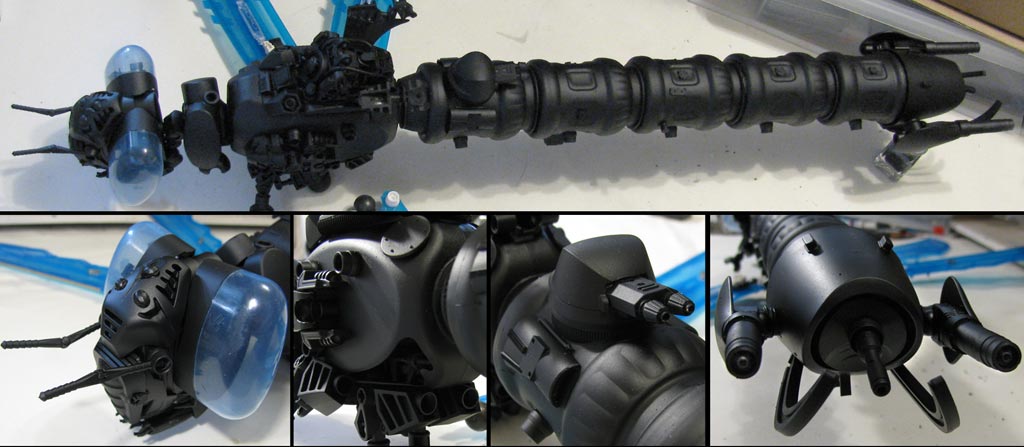
ENTRY: Zoidfans Custom Contest - 2010
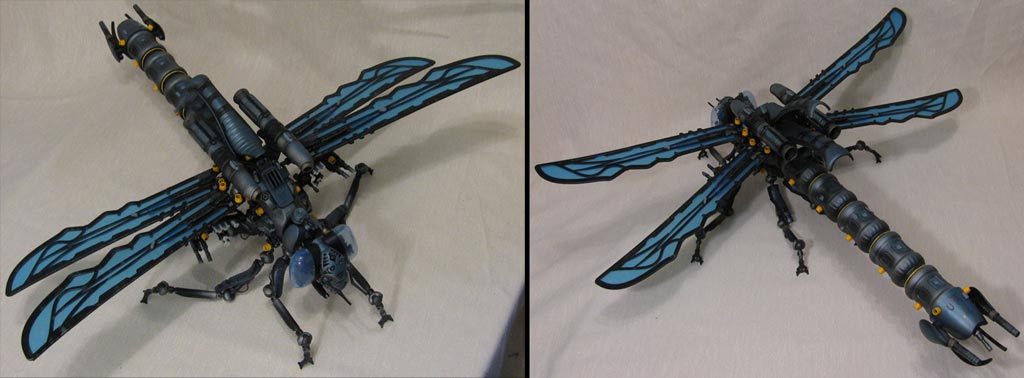






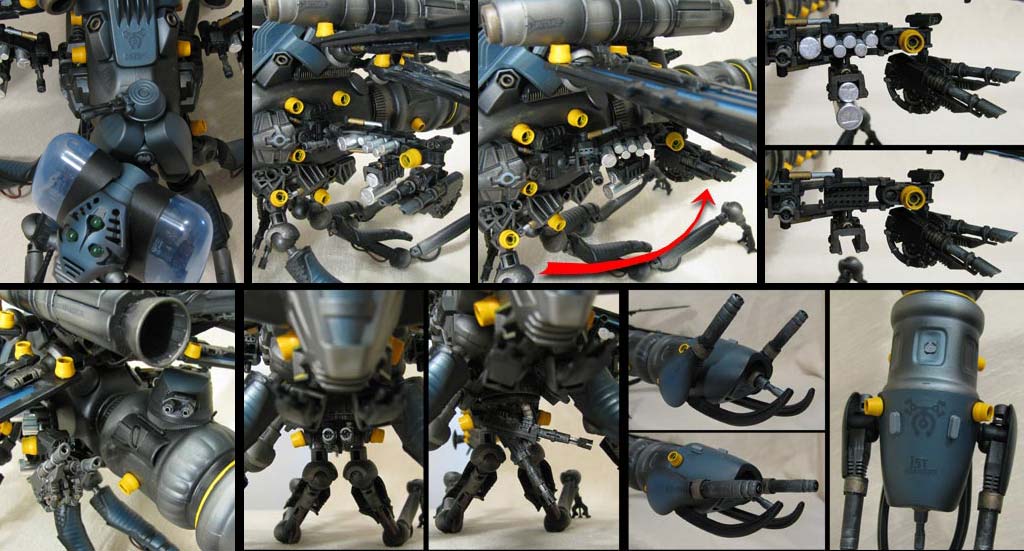
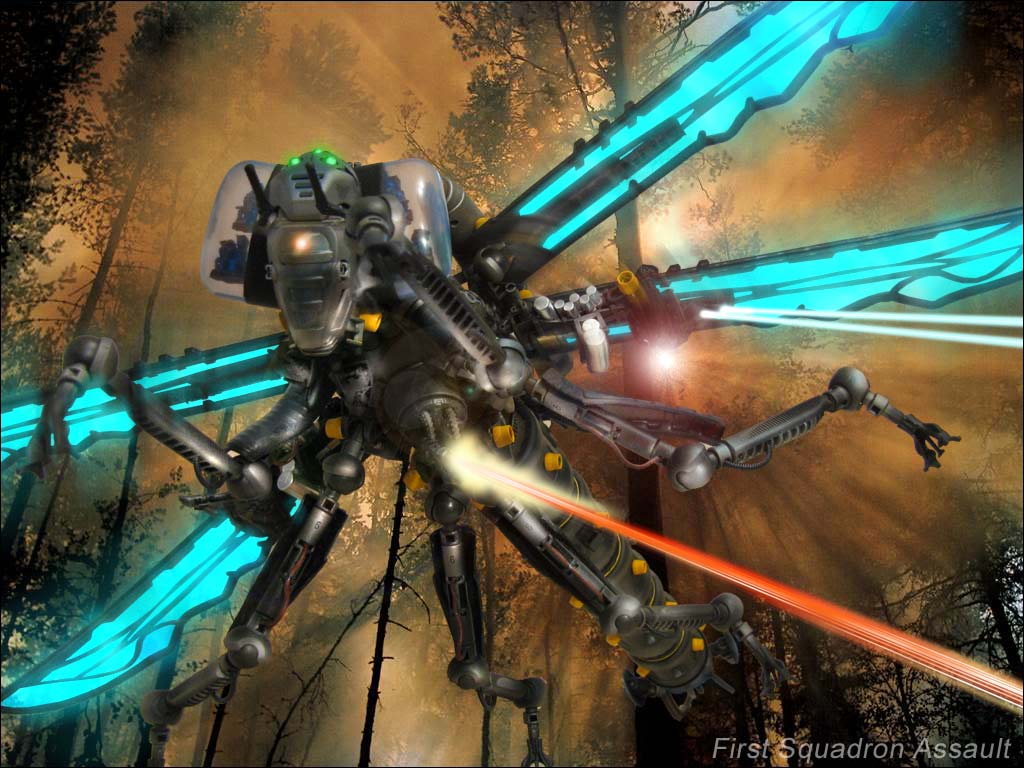
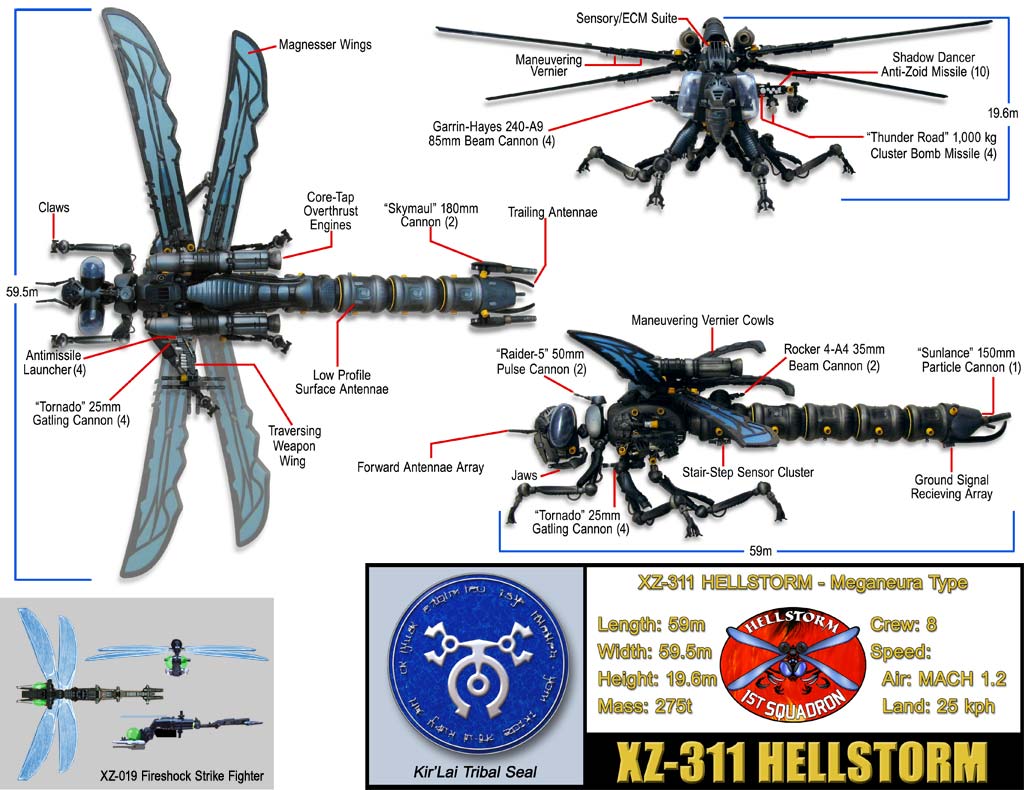
CUSTOM DECALS
I wanted to try something new with the decals on the Hellstorm. The first water slide decals I used were on the Siobhan; solid-printed colors on clear paper. This set was made after observing the decalling on US Navy aircraft; they are transparent gray, designed to be subtle and to blend a bit more like the camouflage on real planes. The implimentation, however, wasn't as striking as I would like. Transparent gray would work well on a model that was a single base color, not the metallic steel/blue of Hellstorm. Seeing them, I would rather have increased the darkness from 30% to more like 60%. Oh, well... better luck next time.



WINGING IT
One of the single most tedious parts of the model was taking the bright blue, soft sword blades and adding the metal supports and surface details (which required finding at least 4 of every component). If I had time I would have added much more detail to emulate a part more like Salamander's wings. Once the bits were all glued on and secured it took about two hours per wing to paint just the base coat... the plastic simply wanted to shrug off the first attempt at painting and I didn't want any light to show through thin spots. In the end, the primed wings looke fantastic.

THANKS FOR READING THROUGH!

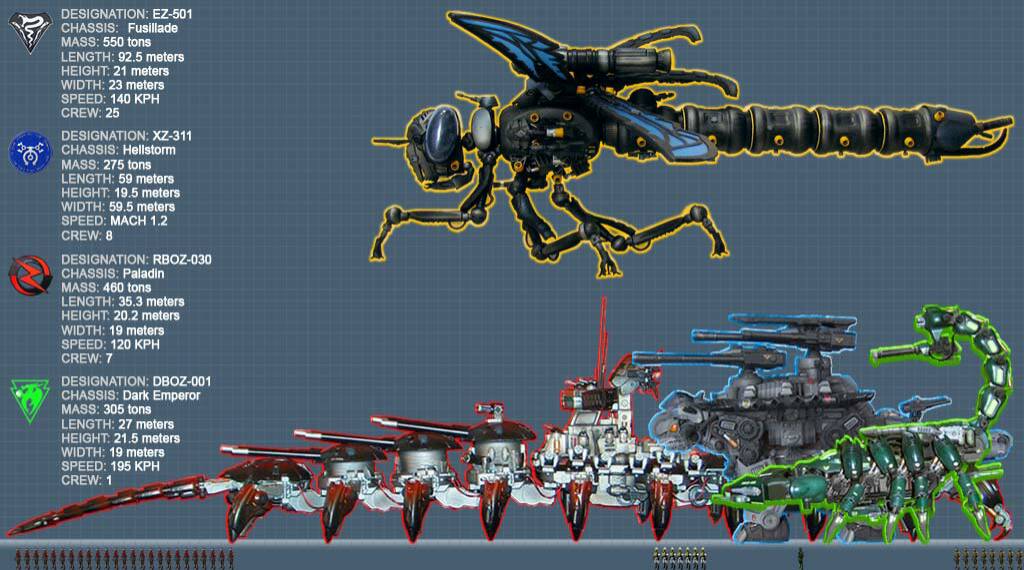
MIGHTY CHAMPIONS
The XZ-311 Hellstorm finds itself in some very good company when compared with some of the mightiest Zoids in the land. Despite its massive size, it is the lightest of the four units presented here; the others being solid, heavily armored ground units loaded with artillery. The XZ-311 is mostly airspace within its frame and its armor is very light; the heaviest components are the central power core and the two overthrust engines. Heavy ordinance is reduced to a handful of missiles and three cannons... all other weapons are lighter and more defensive in nature. The great danger among the four, however, would be the Hellstorm's ability to dart and dodge like the insect it is while blasting over and around the theater of battle beyond MACH.
1st Place Winner
Zoids Poison 2010
Custom Contest

